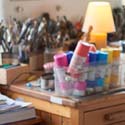Tips to help you stand out in an expo, market or show
“You never get a second chance to make a first impression” ~ Will Rogers I’m not sure I agree with
Read More
“You never get a second chance to make a first impression” ~ Will Rogers I’m not sure I agree with
Read More
Covid-19 and the economic recession has led to many Americans being out of work. Clearly, the fact is that when
Read More
If you’ve never participated in a craft show or market, this can feel like an insurmountable task. Sometimes to the
Read More
Free Webinar | September 9 Is pursuing a career as an entrepreneur the right move for you? Kim Perell, an
Read More
This article is from the Shopify Blog. If you haven’t visited Shopify for your website needs you certainly should invest
Read More
These 12 art business ideas could help you find a way to combine your artistic skills with your business sense.
Read More